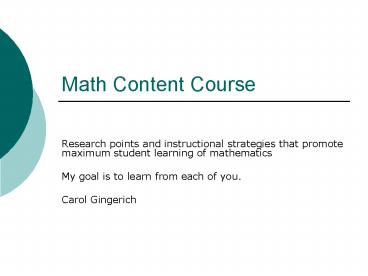Math Content Course - PowerPoint PPT Presentation
1 / 24
Title:
Math Content Course
Description:
Logical sequence of curriculum does not always match text order ... Steps in processes with examples. Resource for homework, study guide or test-taking tool ... – PowerPoint PPT presentation
Number of Views:30
Avg rating:3.0/5.0
Title: Math Content Course
1
Math Content Course
- Research points and instructional strategies that
promote maximum student learning of mathematics - My goal is to learn from each of you.
- Carol Gingerich
2
Goal of Math Instruction
- Student mastery of state-developed curriculum
- Students who ask questions and solve problems
using number sense and logical reasoning - Students who can apply math to their lives
3
Five Strands of Math Proficiency
- Understanding
- Computing
- Applying
- Reasoning
- Engaging
- Are interwoven and interdependent
- National Research Councils Helping Children
Learn Mathematics
4
Understanding
- Comprehension of
- Concepts
- Operations
- Relationships and patterns
- Symbols
- Diagrams
- Procedures
- Helping Children Learn Mathematics
5
Computing
- Carry out mathematical procedures
- Flexibly
- Accurately
- Efficiently
- Appropriately know when and how
- Helping Children Learn Mathematics
6
Applying
- Being able to formulate problems mathematically
- Devise strategies for solving problems
- Use concepts and procedures appropriately
- Distinguish the known and relevant from the
unknown - Helping Children Learn Mathematics
7
Reasoning
- The glue that holds math together
- Using logic to explain and justify a solution to
a problem - Extend from the known to the unknown
- Communicate thinking to others
- Helping Children Learn Mathematics
8
Engaging
- Key to success as a mathematician
- Seeing mathematics as
- Sensible
- Useful
- Doable
- Experience the rewards Celebrate!
- Recognize benefits of perseverance
- Helping Children Learn Mathematics
9
Teaching Students Mathematics
- Student-centered when possible
- Content skills and processes
- Measurable objectives
- Authentic assessment
- Frequent review of concepts mastered
10
Goal of the Daily Lesson
- Know the anchor or standard you are teaching
- Write the objective on the board and refer to it
at the start - Use for heading in math journals if notes are to
be taken during lesson
11
Know Previous Years Anchors
- What skills have they mastered?
- Review/reteach concepts based on need of class or
individual students - Start from what they know and build upon this
12
Suggested Lesson Format
- 8 to 12 minutes of direct instruction for grades
3 -7 - Time for processing
- Rotating mini-lessons
- Group work
- Individual work
- Reflections
- Team project time
- Teaching with the Brain in Mind
13
Additions to Lessons
- Use literature to introduce concepts
- Students create and use games
- Math centers to practice or review
- Use interactive websites if SMART Board or
projector is available
14
Maintaining Student Attention
- Active learning strategies increase student
engagement and help cut down on misbehaviors - Teacher moves around room during instruction
- Students change locations during certain time
blocks of the class - Use fun and energizing rituals for openings and
closings - Teaching with the Brain in Mind
15
Compelling Whys of Learning
- Fun promotes retention
- Freedom enjoy choices
- Power successful mathematicians
- Belonging community of learners
- From PLS course Teaching Through the Learning
Channels
16
Types of Learners
- Try to address each type of learner in every
lesson if possible - Visual colors, shapes, patterns
- Auditory songs, chants, rhythm
- Tactile love of math
- Kinesthetic motions
- Teaching Through the Learning Channels
17
Solid, effective guided instruction is the
balance of
- Concept development build understanding the
why - Procedural proficiency skills performed
- Problem-solving thinking and reasoning
- Harcourt Publishing research
18
PSSA success dependent upon
- Vocabulary language of test
- Basic facts strategies practice
- Problem-solving and reasoning (especially
open-ended questions) - Test preparation strategies
- Harcourt Publishing
19
Know the Vocabulary
- Anchors glossaries
- Standards glossaries
- Teachers manual list
- Vocabulary cards available with new text series
- Create flashcards/sentence strips
- Games Quizmo, Concentration, student-created
cards, Jeopardy
20
Use Authentic Assessments
- PSSA released items
- Math Coach
- Buckle Down Mathematics
21
Modeling and Scaffolding
- Direct instruction
- Partner or small group practice
- Independent practice
- Reasonable amount of homework if mastery of skill
is not achieved - Provide timely feedback on assignments
22
Concrete to Abstract Learning
- Begin with manipulatives/models whenever possible
- Move to drawings in journals and practice
frequently with students who need this strategy - Move to abstract numbers when student is ready
23
Planning and Pacing Guides
- Based on grade level anchors
- Chunk related content metric measurements
- Logical sequence of curriculum does not always
match text order - Are works in progress anchors have been refined
yearly - School-wide or grade-level
24
Use of Math Journals and Folders
- Eliminates disorganization and frustration
- Write vocabulary word, definition and examples
- Steps in processes with examples
- Resource for homework, study guide or test-taking
tool































